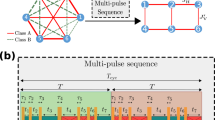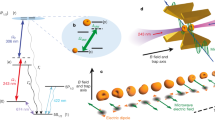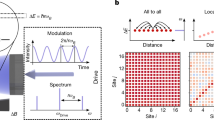Abstract
Quantum simulation1,2—the use of one quantum system to simulate a less controllable one—may provide an understanding of the many quantum systems which cannot be modelled using classical computers. Considerable progress in control and manipulation has been achieved for various quantum systems3,4,5, but one of the remaining challenges is the implementation of scalable devices. In this regard, individual ions trapped in separate tunable potential wells are promising6,7,8. Here we implement the basic features of this approach and demonstrate deterministic tuning of the Coulomb interaction between two ions, independently controlling their local wells. The scheme is suitable for emulating a range of spin–spin interactions, but to characterize the performance of our set-up we select one that entangles the internal states of the two ions with a fidelity of 0.82(1) (the digit in parentheses shows the standard error of the mean). Extension of this building block to a two-dimensional network, which is possible using ion-trap microfabrication processes9, may provide a new quantum simulator architecture with broad flexibility in designing and scaling the arrangement of ions and their mutual interactions. To perform useful quantum simulations, including those of condensed-matter phenomena such as the fractional quantum Hall effect, an array of tens of ions might be sufficient4,10,11.
This is a preview of subscription content, access via your institution
Access options
Subscribe to this journal
Receive 51 print issues and online access
$199.00 per year
only $3.90 per issue
Buy this article
- Purchase on Springer Link
- Instant access to full article PDF
Prices may be subject to local taxes which are calculated during checkout



Similar content being viewed by others
References
Feynman, R. P. Simulating physics with computers. Int. J. Theor. Phys. 21, 467–488 (1982)
Lloyd, S. Universal quantum simulators. Science 273, 1073–1078 (1996)
Ladd, T. D. et al. Quantum computers. Nature 464, 45–53 (2010)
Georgescu, I. M., Ashhab, S. & Nori, F. Quantum simulation. Rev. Mod. Phys. 86, 153–185 (2014)
Blatt, R. & Roos, C. F. Quantum simulations with trapped ions. Nature Phys. 8, 277–284 (2012)
Chiaverini, J. & Lybarger, W. E. Laserless trapped-ion quantum simulations without spontaneous scattering using microtrap arrays. Phys. Rev. A 77, 022324 (2008)
Schmied, R., Wesenberg, J. H. & Leibfried, D. Optimal surface-electrode trap lattices for quantum simulation with trapped ions. Phys. Rev. Lett. 102, 233002 (2009)
Shi, T. & Cirac, J. I. Topological phenomena in trapped-ion systems. Phys. Rev. A 87, 013606 (2013)
Seidelin, S. et al. Microfabricated surface-electrode ion trap for scalable quantum information processing. Phys. Rev. Lett. 96, 253003 (2006)
Friedenauer, A., Schmitz, H., Glueckert, J. T., Porras, D. & Schaetz, T. Simulating a quantum magnet with trapped ions. Nature Phys. 4, 757–761 (2008)
Nielsen, A. E. B., Sierra, G. & Cirac, J. I. Local models of fractional quantum Hall states in lattices and physical implementation. Nature Commun. 4, 2864 (2013)
Schmied, R., Wesenberg, J. H. & Leibfried, D. Quantum simulation of the hexagonal Kitaev model with trapped ions. New J. Phys. 13, 115011 (2011)
Wineland, D. J. et al. Experimental issues in coherent quantum-state manipulation of trapped atomic ions. J. Res. Natl Inst. Stand. Technol. 103, 259–328 (1998)
Cirac, J. I. & Zoller, P. A scalable quantum computer with ions in an array of microtraps. Nature 404, 579–581 (2000)
Kielpinski, D., Monroe, C. & Wineland, D. J. Architecture for a large-scale ion-trap quantum computer. Nature 417, 709–711 (2002)
Brown, K. R. et al. Coupled quantized mechanical oscillators. Nature 471, 196–199 (2011)
Harlander, M., Lechner, R., Brownnutt, M., Blatt, R. & Hänsel, W. Trapped-ion antennae for the transmission of quantum information. Nature 471, 200–203 (2011)
Heinzen, D. J. & Wineland, D. J. Quantum-limited cooling and detection of radio-frequency oscillations by laser-cooled ions. Phys. Rev. A 42, 2977–2994 (1990)
Schmidt, P. O. et al. Spectroscopy using quantum logic. Science 309, 749–752 (2005)
Daniilidis, N., Lee, T., Clark, R., Nararyanan, S. & Häffner, H. Wiring up trapped ions to study aspects of quantum information. J. Phys. B 42, 154012 (2009)
Ciaramicoli, G., Marzoli, I. & Tombesi, P. Scalable quantum processor with trapped electrons. Phys. Rev. Lett. 91, 017901 (2003)
Kim, K. et al. Quantum simulation of frustrated Ising spins with trapped ions. Nature 465, 590–593 (2010)
Britton, J. W. et al. Engineered two-dimensional Ising interactions in a trapped-ion quantum simulator with hundreds of spins. Nature 484, 489–492 (2012)
Bermudez, A., Schmidt, P. O., Plenio, M. B. & Retzker, A. Robust trapped-ion quantum logic gates by continuous dynamical decoupling. Phys. Rev. A 85, 040302(R) (2012)
Tan, T. R. et al. Demonstration of a dressed-state phase gate for trapped ions. Phys. Rev. Lett. 110, 263002 (2013)
Porras, D. & Cirac, J. I. Effective quantum spin systems with trapped ions. Phys. Rev. Lett. 92, 207901 (2004)
Chou, C. W., Hume, D. B., Thorpe, M. J., Wineland, D. J. & Rosenband, T. Quantum coherence between two atoms beyond Q = 1015. Phys. Rev. Lett. 106, 160801 (2011)
Sackett, C. A. et al. Experimental entanglement of four particles. Nature 404, 256–259 (2000)
Hite, D. A. et al. 100-fold reduction of electric-field noise in an ion trap cleaned with in situ argon-ion-beam bombardment. Phys. Rev. Lett. 109, 103001 (2012)
Hauke, P. et al. Can one trust quantum simulators? Rep. Prog. Phys. 75, 082401 (2012)
Leibfried, D. et al. Experimental demonstration of a robust, high-fidelity geometric two ion-qubit phase gate. Nature 422, 412–415 (2003)
Jünemann, J., Cadarso, A., Pérez-García, D., Bermudez, A. & García-Ripoll, J. J. Lieb-Robinson bounds for spin-boson lattice models and trapped ions. Phys. Rev. Lett. 111, 230404 (2013)
Hayes, D. et al. Coherent error suppression in multiqubit entangling gates. Phys. Rev. Lett. 109, 020503 (2012)
Efron, B. & Tibshirani, R. J. An Introduction to the Bootstrap (Chapman & Hall, 1993)
Cirac, J. I. & Zoller, P. Goals and opportunities in quantum simulation. Nature Phys. 8, 264–266 (2012)
Knill, E. Quantum computing. Nature 463, 441–443 (2010)
Leibfried, D. Could a boom in technologies trap Feynman’s simulator? Nature 463, 608 (2010)
Li, J. et al. Motional averaging in a superconducting qubit. Nature Commun. 4, 1420 (2013)
Tseng, C. H. et al. Quantum simulation with natural decoherence. Phys. Rev. A 62, 032309 (2000)
Acknowledgements
We thank K. McCormick, A. Keith and D. Allcock for comments on the manuscript. This research was funded by the Office of the Director of National Intelligence (ODNI), Intelligence Advanced Research Projects Activity (IARPA), ONR, and the NIST Quantum Information Program. All statements of fact, opinion or conclusions contained herein are those of the authors and should not be construed as representing the official views or policies of IARPA or the ODNI. This work, a submission of NIST, is not subject to US copyright.
Author information
Authors and Affiliations
Contributions
A.C.W. and D.L. designed the experiment, developed components of the experimental apparatus, collected data, analysed results and wrote the manuscript. D.L. developed the theory. Y.C. fabricated the ion-trap chip. K.R.B. built components of the apparatus, most notably the cryostat, and participated in the early design phase of the experiment. E.K. assisted with data analysis. D.J.W. participated in the design and analysis of the experiment. All authors discussed the results and the text of the manuscript.
Corresponding author
Ethics declarations
Competing interests
The authors declare no competing financial interests.
Rights and permissions
About this article
Cite this article
Wilson, A., Colombe, Y., Brown, K. et al. Tunable spin–spin interactions and entanglement of ions in separate potential wells. Nature 512, 57–60 (2014). https://doi.org/10.1038/nature13565
Received:
Accepted:
Published:
Issue Date:
DOI: https://doi.org/10.1038/nature13565
This article is cited by
-
Quantum-enhanced sensing of a single-ion mechanical oscillator
Nature (2019)
-
Intensity stabilisation of optical pulse sequences for coherent control of laser-driven qubits
Applied Physics B (2018)
-
Classical-to-quantum transition behavior between two oscillators separated in space under the action of optomechanical interaction
Scientific Reports (2017)
-
Playing tricks to ions
Applied Physics B (2017)
-
Robust entanglement between a movable mirror and atomic ensemble and entanglement transfer in coupled optomechanical system
Scientific Reports (2016)
Comments
By submitting a comment you agree to abide by our Terms and Community Guidelines. If you find something abusive or that does not comply with our terms or guidelines please flag it as inappropriate.



